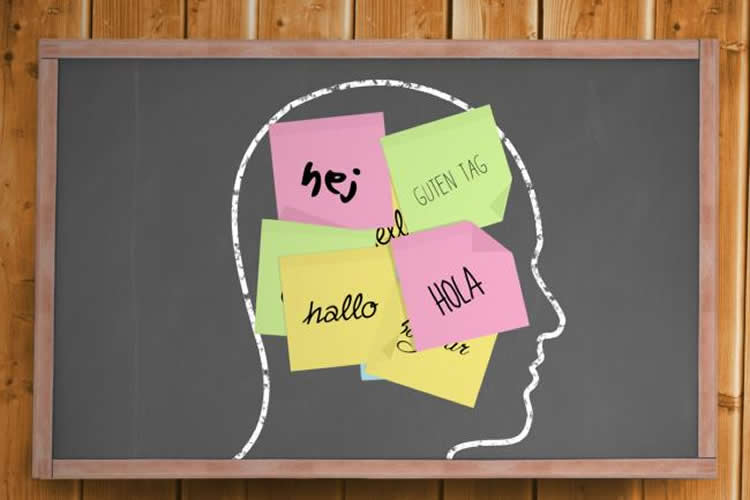Summary: Brain activity of bilingual people who learn a new language is similar to that of native speakers of that language within one day of training, a new study reports. For monolingual people, it takes much longer to exhibit P600 brain activity following language learning.
Source: GUMC.
It is often claimed that bilinguals are better than monolinguals at learning languages. Now, the first study to examine bilingual and monolingual brains as they learn an additional language offers new evidence that supports this hypothesis, researchers say.
The study, conducted at Georgetown University Medical Center and published in the journal Bilingualism: Language and Cognition, suggests that early bilingualism helps with learning languages later in life.
“The difference is readily seen in language learners’ brain patterns. When learning a new language, bilinguals rely more than monolinguals on the brain processes that people naturally use for their native language,” says the study’s senior researcher, Michael T. Ullman, PhD, professor of neuroscience at Georgetown.
“We also find that bilinguals appear to learn the new language more quickly than monolinguals,” says lead author Sarah Grey, PhD, an assistant professor in the department of modern languages and literatures at Fordham University. Grey worked with Ullman and co-author Cristina Sanz, PhD, on this study for her PhD research at Georgetown. Sanz is a professor of applied linguistics at Georgetown.
The 13 bilingual college students enrolled in this study grew up in the U.S. with Mandarin-speaking parents, and learned both English and Mandarin at an early age. The matched comparison group consisted of 16 monolingual college students, who spoke only English fluently.

The researchers studied Mandarin-English bilinguals because both of these languages differ structurally from the new language being learned. The new language was a well-studied artificial version of a Romance language, Brocanto2, that participants learned to both speak and understand. Using an artificial language allowed the researchers to completely control the learners’ exposure to the language.
The two groups were trained on Brocanto2 over the course of about a week. At both earlier and later points of training, learners’ brain patterns were examined with electroencephalogram (EEG) electrodes on their scalps, while they listened to Brocanto2 sentences. This captures the natural brain-wave activity as the brain processes language.
They found clear bilingual/monolingual differences. By the end of the first day of training, the bilingual brains, but not the monolingual brains, showed a specific brain-wave pattern, termed the P600. P600s are commonly found when native speakers process their language. In contrast, the monolinguals only began to exhibit P600 effects much later during learning — by the last day of training. Moreover, on the last day, the monolinguals showed an additional brain-wave pattern not usually found in native speakers of languages.
“There has been a lot of debate about the value of early bilingual language education,” says Grey. “Now, with this small study, we have novel brain-based data that points towards a distinct language-learning benefit for people who grow up bilingual.”
The other study co-author is psycholinguist Kara Morgan-Short, PhD, from the University of Illinois at Chicago, who also conducted her graduate work with Sanz and Ullman.
Funding: This research was supported by a National Science Foundation grant (NSF-BCS 1124144).
Source: Karen Teber – GUMC
Image Source: NeuroscienceNews.com image is adapted from the GUMC news release.
Original Research: Abstract for “Bilingual and monolingual adults learning an additional language: ERPs reveal differences in syntactic processing” by Sarah Grey, Cristina Sanz, Kara Morgan-Short and Michael T. Ullman in Bilingualism: Language and Cognition. Published online October 2 2017 doi:10.1017/S1366728917000426
[cbtabs][cbtab title=”MLA”]GUMC “Bilingual People May Find it Easier to Learn New Languages.” NeuroscienceNews. NeuroscienceNews, 2 October 2017.
<https://neurosciencenews.com/learning-language-bilingual-7632/>.[/cbtab][cbtab title=”APA”]GUMC (2017, October 2). Bilingual People May Find it Easier to Learn New Languages. NeuroscienceNews. Retrieved October 2, 2017 from https://neurosciencenews.com/learning-language-bilingual-7632/[/cbtab][cbtab title=”Chicago”]GUMC “Bilingual People May Find it Easier to Learn New Languages.” https://neurosciencenews.com/learning-language-bilingual-7632/ (accessed October 2, 2017).[/cbtab][/cbtabs]
Abstract
Bilingual and monolingual adults learning an additional language: ERPs reveal differences in syntactic processing
It has been suggested that bilinguals learn additional languages ‘better’ than monolinguals. However, evidence is sparse, particularly for grammar. We examined behavioral and neural correlates of learning an additional (artificial) language in early Mandarin–English bilinguals, compared to English monolinguals. Following grammar instruction, participants practiced comprehension and production, and judged grammaticality at low and high proficiency while event-related potentials (ERPs) were acquired. Bilinguals and monolinguals did not differ on behavioral measures, but showed distinct ERP patterns. At low proficiency only bilinguals showed a P600, a common ERP correlate of syntactic processing in native speakers of languages. At high proficiency both groups showed P600s, though the monolinguals also evidenced an anterior positivity not typically found in native speakers of languages during syntactic processing. These findings suggest that, even without bilingual/monolingual behavioral differences, bilinguals show ERP patterns for an additional language that are more similar to those of native speakers of languages.
“Bilingual and monolingual adults learning an additional language: ERPs reveal differences in syntactic processing” by Sarah Grey, Cristina Sanz, Kara Morgan-Short and Michael T. Ullman in Bilingualism: Language and Cognition. Published online October 2 2017 doi:10.1017/S1366728917000426







